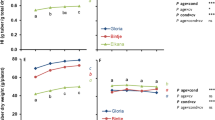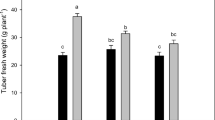Abstract
The growth and tuberization of Norland potatoes were studied under five different temperatures and two photoperiods. Treatment levels included 12, 16, 20, 24, and 28 C with either a 24-h (continuous light) or a 12-h photoperiod at 400 μmol m-2 s-1 PPF. Plants were grown in 6-liter containers and harvested at 56-days-age. Stem length increased with increasing temperature under both photoperiods. The highest tuber yield occurred at 16 C under the 24-h photoperiod (755 g/plant) and at 20 C under the 12-h photoperiod (460 g/plant). Little or no tuber formation occurred at 28 C under either photoperiod or at 24 C under continuous light. As with tuber yield, the highest total plant dry weights also occurred at 16 C under the 24-h photoperiod and at 20 C under the 12-h photoperiod. Harvest index (tuber dry weight to total dry weight ratio) decreased with increasing temperatures and with continuous light. Results indicate that good growth and tuberization can occur under continuous light, and that increasing the photoperiod from 12 to 24 h effectively decreased the optimal temperature for tuber formation from near 20 C to 16 C. Alternatively, the results imply that at cooler temperatures, the potato becomes less obligate for dark period stimulation of tuberization.
Resumen
Se estudió el crecimiento y tuberización de papas Norland, bajo cinco diferentes temperaturas y dos fotoperíodos. Los niveles de los tratamientos incluyeron 12, 16, 20, 24, y 28°C con un fotoperiodo de 24-h (luz continua), o uno de 12-h, con 400 μmol m-2 s-1 PPF. Las plantas fueron desarrolladas en recipientes de 6 litros, y cosechadas a los 56 días de edad. La longitud del tallo aumentó con el aumento de temperatura bajo ambos fotoperiodos. Los rendimientos en tubérculos más altos se produjeron a 16°C bajo un fotoperíodo de 24-h (755 g/planta), y a 20°C bajo un fotoperíodo de 12-h (460 g/planta). Se produjeron pocos o ningún tubérculo a 28°C, bajo cualquiera de los fotoperíodos, o a 24°C bajo luz continua. Al igual que con el rendimiento en tubérculos, los pesos secos totales de las plantas más altos también se presentaron a 16°C bajo el fotoperiodo de 24-h y a 20°C bajo el fotoperíodo de 12-h. El Indice de cosecha (peso seco de tubérculo/peso seco total) disminuyó con el aumento de temperatura y con la iluminación continua. Los resultados indican que un buen crecimiento y tuberización pueden tener lugar bajo condiciones de luz continua, y que incrementando el fotoperíodo de 12 a 24-h, disminuye efectivamente la temperatura óptima para la formación de tubérculos, de cerca de 20°C a 16°C. Alternativamente, los resultados implican que a temperaturas más frías, la papa se ve menos necesitada de pasar por un período de obscuridad, que estimule la tuberización.
Similar content being viewed by others
Literature Cited
Bodlaender, K.B.A. 1963. Influence of temperature, radiation, and photoperiod on development and yield, pp. 199–210.In: J.D. Ivins and F.L. Milthorpe (eds.). The growth of the potato. Butterworths, London.
Bushneil, J. 1925. The relation of temperature to growth and respiration in the potato plant. Univ Minnesota Agric Exp Stn Tech Bull 34.
Ewing, E.E. 1981. Heat stress and the tuberization stimulus. Am Potato J 58:31–49.
Garner, W.W. and H.A. Allard. 1923. Further studies in photoperiodism, the response of the plant to relative length of day and night. J Agric Res 23:871–920.
Gregory, L.E. 1956. Some factors for tuberization in the potato plant. Am J Bot 43:281–288.
Gregory, L.E. 1965. Physiology of tuberization in plants. Ency Plant Physiol 15:1328–1354.
Hammer, P.A., T.W. Tibbitts, R.W. Langhans, and J.C. McFarlane. 1978. Baseline growth of ‘Grand Rapids’ lettuce in controlled environments. J Am Soc Hortic Sci 103:649–655.
Hammes, P.S. and P.C. Nel. 1975. The effect of photoperiod on growth and yield of potatoes (Solanum tuberosum L.) in controlled environments. Agroplantae 7:7–121.
Hussey, G. and N.J. Stacey. 1981.In vitro propagation of potato (Solanum tuberosum L.). Ann Bot 48:787–796.
Marinus, J. and K.B.A. Bodlaender. 1975. Response of some potato varieties to temperature. Potato Res 18:189–204.
McCown, B.H. and I. Kass. 1977. Effect of production temperature on seed potatoes on subsequent yielding potential. Am Potato J 54:277–287.
Mendoza, H.A. and F.L. Haynes. 1976. Variability for photoperiodic reaction among diploid and tetraploid potato clones from three taxonomic groups. Am Potato J 53:319–332.
Menzel, C.M. 1983. Tuberization in potato at high temperatures: Interaction between shoot and root temperatures. Ann Bot 52:65–70.
Menzel, C.M. 1985. Tuberization in potato at high temperatures: Interaction between temperature and irradiance. Ann Bot 55:35–39.
Steward, F.C., U. Moreno, and W.M. Roca. 1981. Growth, form and composition of potato plants as affected by environment. Ann Bot 48:1–45 (suppl. 2).
Went, F.C. 1957. The experimental control of plant growth. Chronica Botanica Co., Waltham, MA.
Werner, H.O. 1942. Relative response of several varieties of potatoes to progressively changing temperatures and photoperiods controlled to simulate “northern” and “southern” conditions. Am Potato J 19:30–40.
Wheeler, R.M. and T.W. Tibbitts. 1986a. Growth and tuberization of potato (Solanum tuberosum L.) under continuous light. Plant Physiol 80:801–804.
Wheeler, R.M. and T.W. Tibbitts. 1986b. Utilization of potatoes for life support systems in space. I. Cultivar-photoperiod interactions. Am Potato J 63:315–323.
Author information
Authors and Affiliations
Additional information
Supported by College of Agriculture and Science, University of Wisconsin, Madison, and NASA Cooperative Agreements NCC 2-136 and NCC 2-301.
Rights and permissions
About this article
Cite this article
Wheeler, R.M., Steffen, K.L., Tibbitts, T.W. et al. Utilization of potatoes for life support systems II. The effects of temperature under 24-H and 12-H photoperiods. American Potato Journal 63, 639–647 (1986). https://doi.org/10.1007/BF02852926
Accepted:
Issue Date:
DOI: https://doi.org/10.1007/BF02852926




